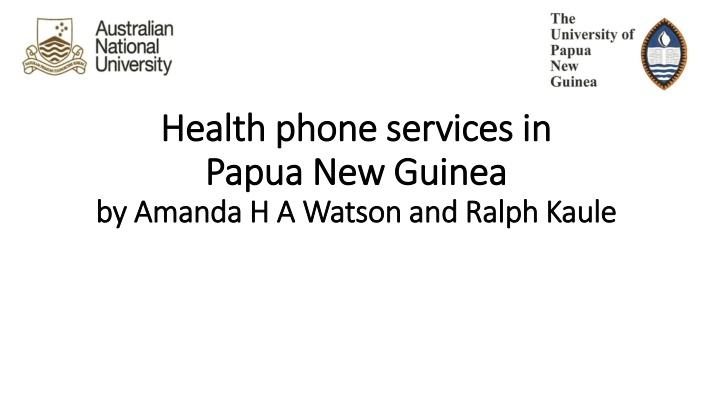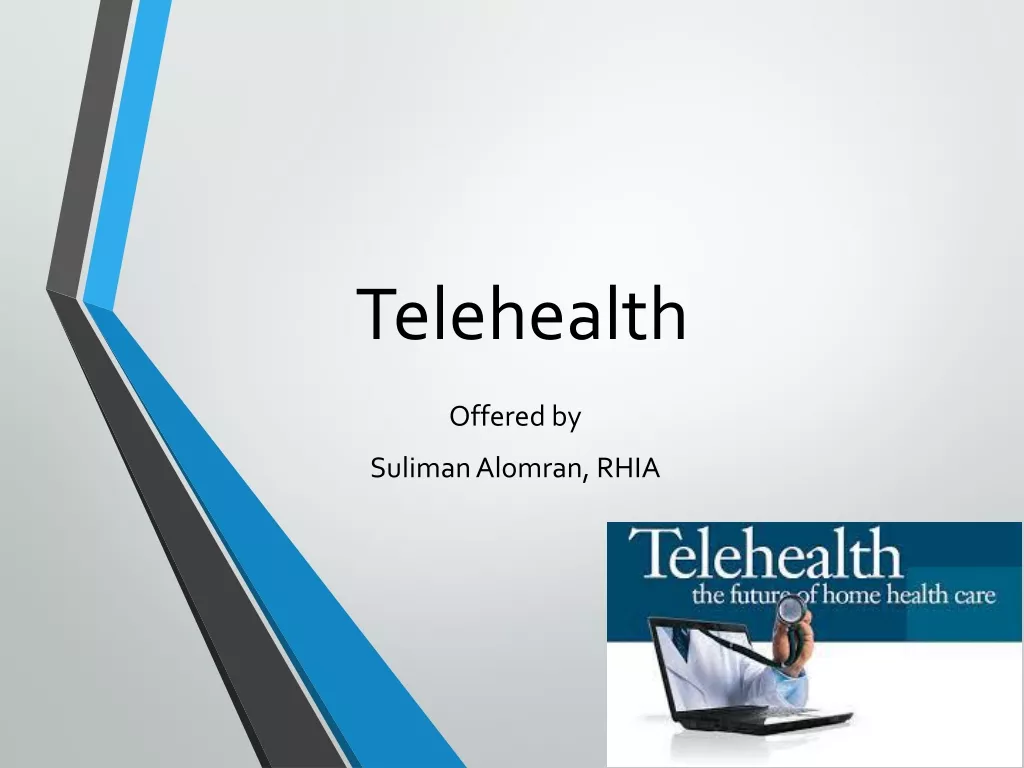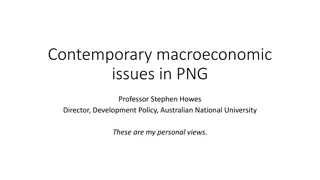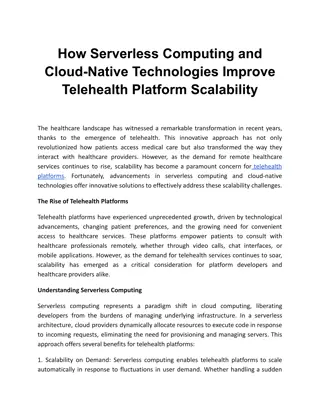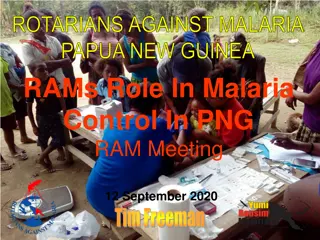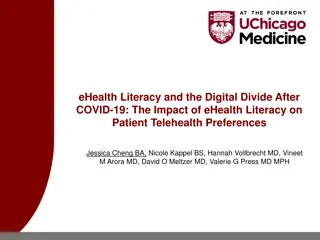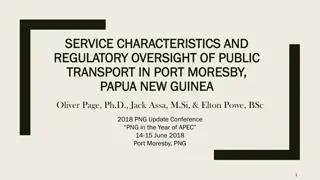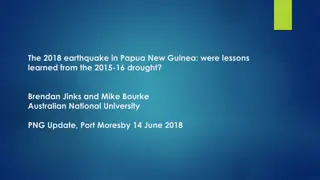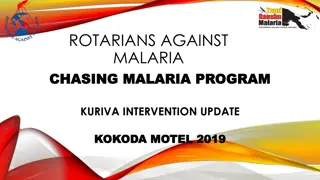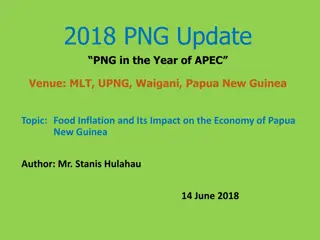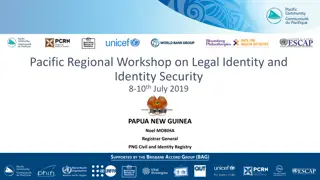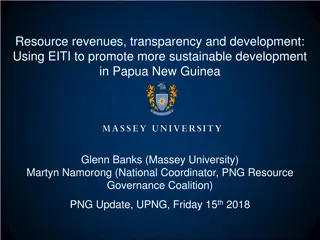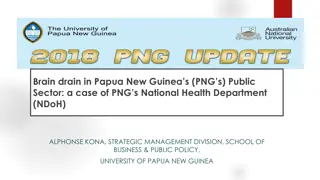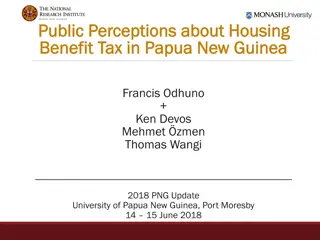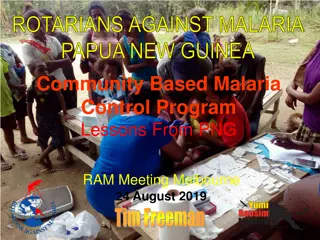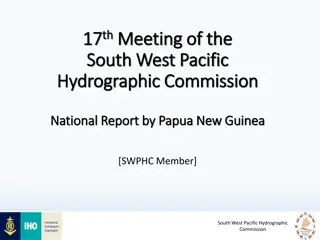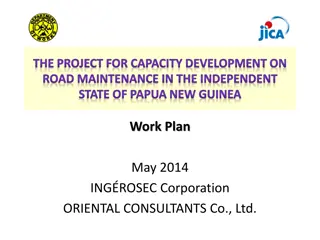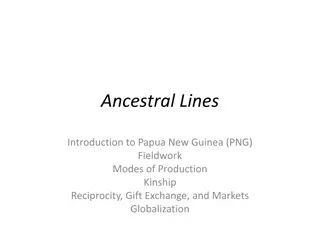Telehealth Services in Papua New Guinea: A Study by Amanda H.A. Watson and Ralph Kaule
Telehealth services in Papua New Guinea, as studied by Watson and Kaule, involve phone consultations and nonphysician services like telenursing. Interviews conducted in Port Moresby, provincial towns, and rural health facilities revealed insights on the interviewee demographics, work experience, and telehealth experience, highlighting the sustainability challenges of aid-funded projects.
Download Presentation

Please find below an Image/Link to download the presentation.
The content on the website is provided AS IS for your information and personal use only. It may not be sold, licensed, or shared on other websites without obtaining consent from the author.If you encounter any issues during the download, it is possible that the publisher has removed the file from their server.
You are allowed to download the files provided on this website for personal or commercial use, subject to the condition that they are used lawfully. All files are the property of their respective owners.
The content on the website is provided AS IS for your information and personal use only. It may not be sold, licensed, or shared on other websites without obtaining consent from the author.
E N D
Presentation Transcript
Health phone services in Health phone services in Papua New Guinea Papua New Guinea by Amanda H A Watson and Ralph Kaule by Amanda H A Watson and Ralph Kaule
Dr Amanda H A Watson Dr Amanda H A Watson ANU-UPNG Partnership Lecturer, Australian National University Visiting Lecturer, University of Papua New Guinea www.ahawatson.com amanda.watson@anu.edu.au Twitter: @ahawatson
Mr Ralph Kaule Mr Ralph Kaule Lecturer, University of Papua New Guinea rkaule@upng.ac.pg Photo: Mr Ralph Kaule conducting a research interview in 2017 (source: Watson)
Telehealth The term telemedicine is typically limited to phone consultations between medical practitioners and patients (Zieli ski, Duplaga & Ingram, 2006). Telehealth is a broad term incorporating telemedicine and a variety of nonphysician services, including telenursing (Weinstein et al., 2014, p. 183).
Papua New Guinea Figure: Map of Papua New Guinea (source: geology.com)
Telehealth Interviews conducted Number Port Moresby 11 Provincial town 11 Rural health facility 2 Total 24
Telehealth Interviewee sex Number Male 13 Female 11 Total 24
Telehealth Interviewee work experience Number Public health professional Telecommunication company employee Rural health worker Health administrator Doctor Nurse Trained counsellor 6 5 4 4 2 2 1 Total 24
Telehealth Interviewee telehealth experience Number Currently works, or has worked, managing a telehealth service Has not used a telehealth service Currently works, or has worked, answering calls Experience as a client of a telehealth service (e.g. rural health worker) 18 3 2 1 Total 24
Telehealth Sustainability is a key factor regarding innovations financed by aid. In PNG, some aid-funded telehealth projects have been sustainable and are ongoing, whilst others have not been sustainable and have ceased to operate.
Telehealth What factors lead to failure and/or success of a telehealth service in PNG?
Telehealth A key lesson learnt is that phone services which are open to the public are expensive, requiring long-term investment and strategic, sustained promotional activities. Photos: Digicel call centre, Port Moresby (source: Watson 2017)
Telehealth There has to be consistent flow of funding, especially for this, this program that there is continuation of service. [ ] If programmes like call centre has to come in, there has to be sufficient budget for it . to, you know, maintain its, ahh, maintain the services, and that s vital. Source: Research interview
Telehealth All the rural villagers [ ], they must understand why the call centre exists. If they know the reason for it, I think they will, you know, [ring]. So we have to have, ahh, people, ahh, . have a lot of awareness in the villages, [about] why the call centre is existing, [and] the functions of the call centre, [so that] they can understand this. Source: Research interview Translated from the following interview quote in both Tok Pisin and English: Ol lain long ples [ ], olsem ol i mas understandim why call centre em i exist. Sapos ol i save long reason bilong dispela, me ting olsem olgeta bai wanemia, so we have to have, ahh, people, ahh, . have a lot of awareness in the villages, why the call centre is existing, the functions of call centre. Ol ken understandim dispela.
Telehealth Another key lesson is that phone services which are accessible only to health workers are less costly and can be beneficial in terms of improving health system efficacy and efficiency. Photo: rural health facility, Milne Bay Province (source: Watson) Photo: rural health worker, Western Highlands Province (source: Watson) Photo: ambulance, Western Highlands Province (source: Watson)
Telehealth For the health workers, they get plenty of help through this. Like some, they didn t know how to deliver the baby, mostly it was like maternal, child, ahh, childbirth, and they need help, and they ring. We ring ONG doctors, same hour, same time, they give advice, so then we ring go back [ ] that s the help they get straight away, so it s just like we are talking face-to-face. Source: Research interview Translated from the following interview quote in both Tok Pisin and English: Long sait bilong health worker tu em olsem ol i kisim planti helpim long dispela. Like some they didn t know how to deliver the baby, mostly it was like maternal child ahh, olsem long karim pikinini na ol i nidim helpim na ol sa ring kam, em ol ONG doctors mipla ring, same hour same time ol sa givim advice, so then mipla sa ring go bek [ ] em helpim em ol kisim straight away so it s just like we are talking face-to-face.
Telehealth There are some instances where our staff lives were in, uhh, under threat . and . just a phone call and it . uhh, we, we save them from the threat, you see, amm . previously we receive message, without a phone call, we receive message later that . ohh the vehicle has been stolen, the staff were beaten up, all these. Source: Research interview
Telehealth [It s a] very effective way of referring patients and talking with and readying the health workers. We have phone numbers for all the health centres so we can ring and they can be ready. Because we were given all the numbers for ringing them, so we can ring and say oh, a patient is coming, you [ ] wait for them . [ ] So it s effective assistance. Source: Research interview Translated from the following interview quote in both Tok Pisin and English: Very effective way of referring patients na toktok wantaim narapela wokman mipela redim em long hapsait. Like mipela gat olgeta fon namba bilong olgeta health centre i stap so mipela sa ring na ol sa expectim na stap. Because ol givim mipela ol namba long ringim ol lain tu so mipela ring na tok oh patient kam lo dispela, yu [ ] wetim em . [ ] So em bin helpim effectively.
Telehealth In conclusion, strategic use of phones between health workers has demonstrable benefits.
Health phone services in Health phone services in Papua New Guinea Papua New Guinea by Amanda H A Watson and Ralph Kaule by Amanda H A Watson and Ralph Kaule www.ahawatson.com amanda.watson@anu.edu.au Twitter: @ahawatson rkaule@upng.ac.pg NB: This research was also presented at the Australasian Aid conference, February 2018, Australian National University, Canberra.
